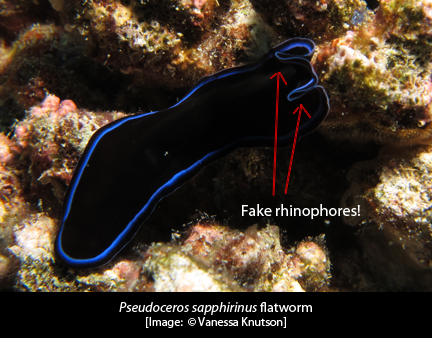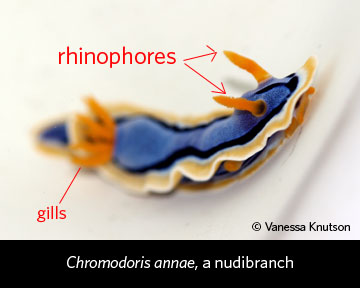Last time we sorted out the difference between sea cucumbers and nudibranchs and now it’s time to mention another nudibranch imposter. This one is a real trickster. Even I’ve been fooled by these on occasion, at least at first. So who are these tricky nudi imposters? Flatworms. Many species of polyclad flatworms are excellent mimics of nudibranchs.

There are three main reasons why I think these can be so difficult to tell apart from nudibranchs:
- Since flatworms are flattened in shape, they often look like nudibranchs from far away.
- Many of the color patterns of these flatworms match the color patterns of different species of nudibranchs, nearly perfectly.
- Often, the edge of these flatworms is rolled up in two spots on one end of the worm and this mimics rhinophores (nudibranch sensory organs) really well. So if you are looking for rhinophores and see these rolled up structures, you may get fooled without a closer look.
My best advice for distinguishing between a nudibranch and a flatworm imposter is to first look for gills. Though not all nudibranchs have gills located externally on their backs, many do. My second piece of advice is to look very closely at what appear to be the rhinophores. If it looks as though this is just the edge of the animal rolled up, you are likely looking at a flatworm and not a nudibranch.


It's been fun explaining some of the differences between nudibranchs and some of the animals that look like them. I've actually been reviewing various kinds of nudibranchs and other sea slugs myself. The reason for this is that in a few weeks I will be heading to Papua New Guinea as a part of an expedition to the Madang Province- Our Planet Reviewed’ Initiative, Papua New Guinea 2012-2103 Expedition.
The next time you hear from me, I'm going to be up to my gills in fieldwork- collecting, photographing and identifying sea slugs for 6 weeks! I will be blogging from the field right here at the Project Lab blog, so stay tuned!
Vanessa Knutson
Project Lab Coordinator
Graduate Student
Invertebrate Zoology and Geology